Self-driving cars are not merely a technological marvel; they represent a monumental shift in the landscape of automotive design and innovation. As autonomous vehicle technology evolves, the future of car design is poised for unprecedented changes that could redefine mobility itself.
The Evolution of Car Design with Automation
The emergence of self-driving cars is ushering in a new era where traditional design norms are challenged. Before automation, vehicle design focused heavily on human drivers, emphasizing aesthetics, comfort, and driver engagement. With autonomous vehicles, designers can focus on creating spaces that enhance passenger interaction and comfort. The interior design of cars will evolve to prioritize relaxation and socialization, as individuals may no longer need to pay attention to the road. Innovation in design will reflect a shift towards multifunctional spaces, incorporating features akin to living rooms or offices.
Integration of Advanced Technology in Vehicles
As self-driving technology progresses, cars will integrate sophisticated sensors, cameras, and AI systems that must be considered from the very beginning of the design process. The placement of these technologies will dictate the overall look and functionality of future vehicles, merging aesthetics with advanced technological capabilities. This integration is essential not only for performance but also for safety, as manufacturers will need to ensure that systems can operate reliably in various environments. The aesthetic appearance will likely evolve to reflect this harmonious blend of form and function.
Impact on Sustainability and Materials
With the push for environmentally friendly transportation, the rise of self-driving cars presents an opportunity to rethink materials and sustainability in car design. Future vehicles are likely to utilize renewable materials and more efficient production processes, reducing waste and environmental impact. Sustainable practices such as 3D printing could significantly lower manufacturing costs and emissions. Additionally, self-driving vehicles can be designed to optimize energy consumption, further aligning design with ecological responsibility.
The Role of User Experience in Autonomous Vehicles
User experience (UX) will become paramount in the design of self-driving cars. As passengers are no longer focused solely on driving, designers will need to create intuitive interfaces that allow for seamless interaction with technology and other passengers. The integration of augmented reality and interactive displays may enhance the experience, providing information or entertainment tailored to the individual needs of passengers. Ensuring a positive user experience will be crucial for the acceptance of autonomous vehicles in the market.
Safety Features and Design Considerations
As self-driving cars enter the mainstream, the need for robust safety features will dominate design discussions. Future vehicles will integrate advanced safety technologies, including automated emergency braking, collision avoidance systems, and real-time hazard detection, directly into their physical form. Designers will need to ensure that these features are not only functional but also easily recognizable to users. Designing for safety will become a key component in gaining consumer trust and ensuring public acceptance of autonomous vehicles.
The Future of Mobility and Urban Design
The rise of self-driving cars will have profound implications for urban planning and mobility as a whole. With reduced need for parking spaces and the potential for more streamlined traffic flow, cities can rethink their physical layouts. This may pave the way for more pedestrian-friendly areas and green spaces. The predictive nature of autonomous vehicles could also lead to more efficient public transport systems, shaping a new future for urban design that prioritizes sustainability and enhanced accessibility. The reimagining of cities is an exciting result of the innovative potential self-driving cars bring.
Disclaimer: The perspectives contained in this article reflect current trends and innovations in the automotive industry and are subject to change as technology evolves.





















